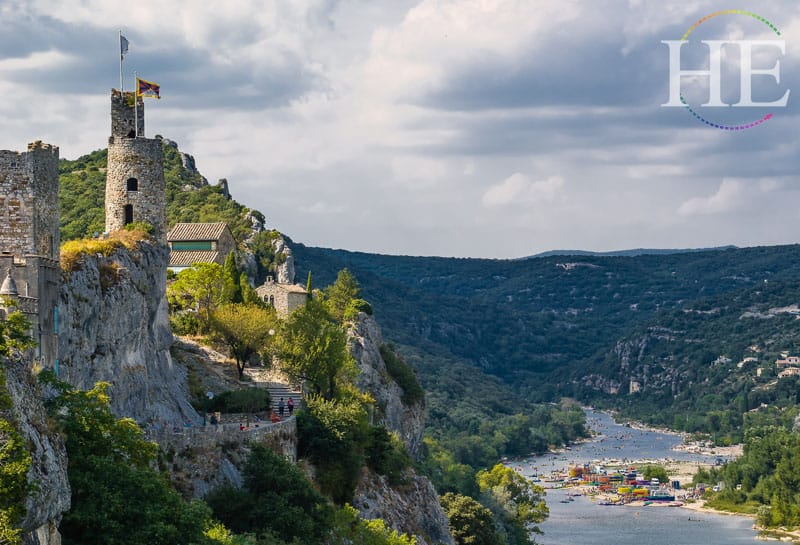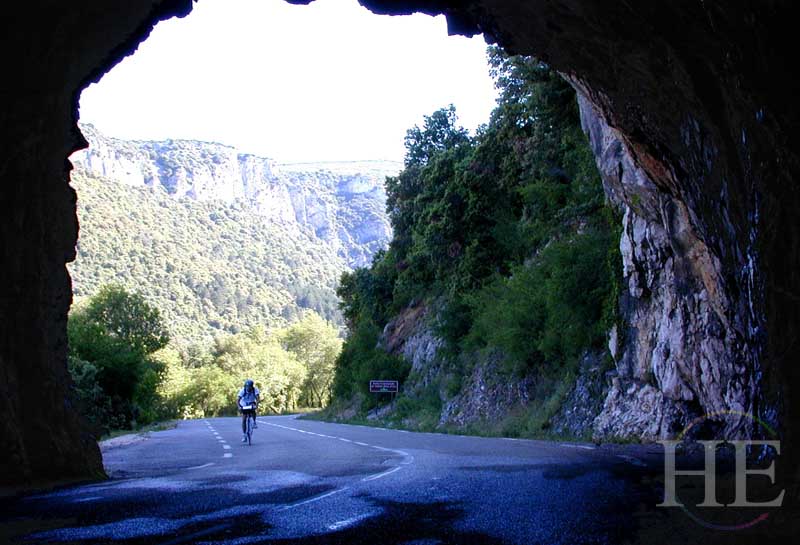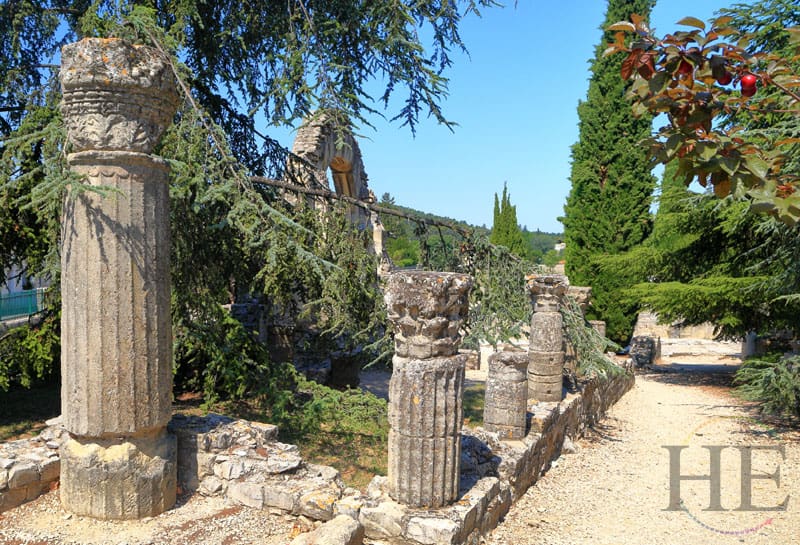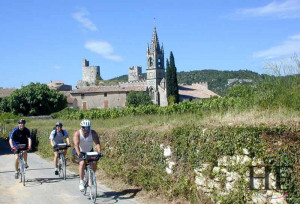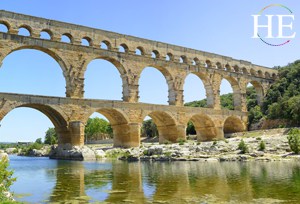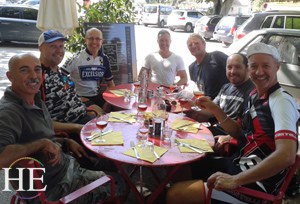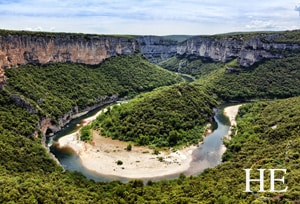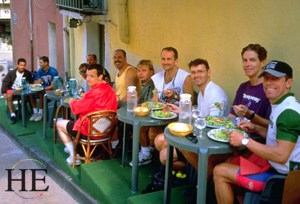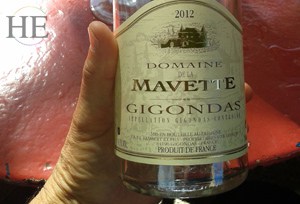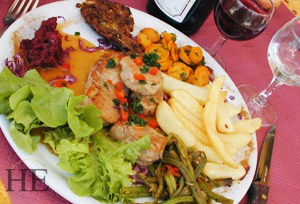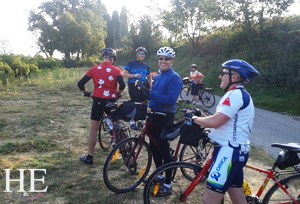Mistral Gay France Bike Tour
A Gay Bike Tour through Provence, France
Bike through Provence and visit Roman theaters, river gorges, a natural rock arch, famous wine country, and walled medieval towns on this gay France bike tour. Primarily a bike vacation, but with many other activities available, all while enjoying the cuisine for which France is famous.
Highlights
Roam Avignon, an ancient city of stone ramparts and belltowers. Explore the mazelike 14th-century Palace of the Popes.
Enjoy a memorable picnic at the Pont du Gard, the 2000-year-old Roman aqueduct considered one of the 7 surviving wonders of the ancient world.
Sip a traditional Provencal pastis as you enjoy a game of boule by a village stream.
Cruise the rim of the Ardeche Gorges, as kayakers battle the brawling rapids a thousand feet below.
Take a moonlit walk along the ramparts walls of Aigueze, as the Milky Way twinkles overhead.
Tour the world’s best-preserved Roman amphitheater.
At the end of each day’s travel, savor a well-earned three-hour gourmet dinner.
Overview
Gorgeous scenery, Roman towns, and 30,000 years of history
Cycle back through time, past prehistoric caves, Roman ruins, and medieval gargoyles. This bike trip takes us into a region of Provence overlooked by most tourists, where we get all the charm of this ancient region, but without the crowds.
Biking out the first day, we travel on quiet country roads, past fields of poppies, to the turreted medieval duchy of Uzes. Then we’re off to the Ardeche Gorges. Bike up a road carved right through the limestone cliffs, then spin 15 miles along the top edge of this natural wonder. Below lies Chauvet Cave, where masterful cave paintings of bison, mammoths, and rhinoceroses, dating back 30,000 years, was discovered in 1994.
We spend a memorable night at the restored chateau in the ancient village of Aigueze, whose cobblestone streets and crumbling towers seem little changed by the centuries. Then come two nights in historic Vaison-la-Romaine, originally settled in Paleolithic times, then a Roman province. Take a moonlit stroll to its ruined hilltop castle, and a brief hike to the nearby village of Crestet, where little seems to have changed for 300 years. Finally, stop for a wine-tasting in celebrated Chateauneuf-du-Pape.
Itinerary
Map:
The region of southern France known as Provence offers enormous variety: Roman theaters, river gorges, famous wine country, and walled medieval towns. Our Mistral bike tour has been carefully planned to highlight many of Provence’s most fascinating sights, connecting them by small roads that are every cyclist’s dream.
The Mistral takes us through a region of great variety and a robust history. Three bridges — ponts in French — symbolize this diversity. The Pont d’Avignon, built in A.D. 1177, made Avignon a major crossroads of Europe and helped lure the Papacy to this city during the Great Schism. The Pont du Gard, erected by the Romans 2000 years ago and still towering overhead (thus outlasting some bridges on the Connecticut Turnpike by 1950 years) reminds us of the extensive and lasting influence of the Romans. And the Pont d’Arc, a natural rock arch over the Ardeche river, is but one of many natural wonders that await us.
This is primarily a bike vacation, but with many other activities available. You can swim under the Pont du Gard and Pont d’Arc, explore narrow streets that date to the Middle Ages, and enjoy the cuisine for which France is famous. Each day, you’ll feel immersed in a new dimension of this historic region.
Day 1: The Pont d’Avignon
We begin in Avignon, a lively city settled by the Romans that today remains an important cultural center of France. Avignon reached its height in the 14th century when much of Europe was in chaos. Pope Clement V fled the anarchy of Rome and made his home here. For 68 years, Avignon served as the papal seat of seven Popes, each adding new embellishments to the palace. Today the enormous maze-like Papal Palace, sitting high on a rock, is a fascinating attraction for visitors.
Some in our group will also recognize Avignon from the childhood song:
Sur le Pont, d’Avignon, l’on y danse, l’on y danse
Sur le Pont, d’Avignon, l’on y danse tous en rond
The famous Pont d’Avignon, built in 1177, still stands — partially. For over four centuries, it offered all of Europe the only permanent crossing of the Rhone between Lyon and the Mediterranean, thus establishing Avignon as a key center of commerce. Washed out by floods in the 17th century, today the bridge goes only halfway across the river.
Our trip officially begins at 6:00 pm with our reception, drinks, and orientation, followed by dinner. If you’re in town by 4:00 pm, join us for a walking tour of Avignon’s cobblestoned streets, taking in the Papal Palace, a ramparts catwalk overlooking the river, a hidden courtyard guarded by scowling gargoyles, the terraced hilltop gardens adjacent to the palace, the Pont d’Avignon, and the bustling town square.
We will have our welcome dinner tonight at one of our favorite restaurants in Avignon.
Day 2: A Roman masterpiece
Avignon to Uzes, 27 miles
Awake to the distant tolling of church bells and the chirp of birds in the trees. Breakfast, and then we’re off!
As we cross the silvery Rhone, glance back at Avignon’s skyline: 14th-century church spires and the turrets of the Papal Palace. A couple of hours of cycling takes us to the Pont du Gard, a 2000-year-old Roman aqueduct. This architectural marvel is considered one of the 7 surviving wonders of the ancient world: It carried water 33 miles from Uzes to the town of Nimes, a total drop of a mere 55 feet. We’ll spread out an elegant picnic below this daunting structure as you climb to the top — or swim in the sparkling waters below.
Already you’ve discovered what’s so special about biking in France. We’ve searched out some wonderful backroads, winding through apricot orchards and past fields redolent with wild rosemary and thyme. In May and June, watch for bright fields of poppies. In autumn, enjoy the excitement of the grape harvest.
Pont Nicolas, an arched medieval bridge, offers an enjoyable stop for those who take a short detour. Soon we arrive in the former duchy of Uzes, a picturesque village with much to see. An early Christian crypt dates to the 4th century; the clocktower from the 12th; and St-Etienne church from the 18th. The market square and grounds of the ducal palace are particularly enjoyable.
Day 3: Swimming, and an arch of rock
Uzes to Vallon Pont d’Arc, 46 miles
If you didn’t have time to tour the ducal palace yesterday, you may want to stop this morning. Then comes a full and varied day of riding.
In the morning, we’ll pass the walled hilltop town of Lussan then follow a meandering forest road. Re-energize with smoked ham and goat cheese, tomato, and basil on a baguette, followed by a flaky pastry, as the swans keep an alert eye for crumbs. Enjoy a game of boules before you start biking again.
After lunch, we bike along the spectacular river gorges of the Ceze river. There’s a secluded bend down on the river where we’ve cooled off on hot days. Bike past cherry orchards and Monteils, where stone barns have served a dozen generations of farmers. You’ll have an opportunity to visit the limestone caverns of Orgnac. In Labastide-de-Virac, visit a chateau that houses a museum of silk, silkworms, and the silk trade, which once enriched this scenic town.

Finally, cross the Ardeche river and make a tough choice. If you’ve still got energy, you can head west to the scenic gorges of the Beaume River, with the hulking Sampzon Rock, the squared ramparts and seven round towers of Ruoms. Otherwise, follow the twisting riverside road. It winds through two tunnels carved into the rock then past the Pont d’Arc, a natural rock arch carved by the river. This is where you’ll probably want to take a dip on a hot day.
After dinner, we’ve been known to return to the Pont d’Arc to enjoy a midnight dip, with rock and stars interplaying in the sky.
Day 4: Gorges of the Ardeche
Vallon Pont d’Arc to Pont-St-Esprit, 30 miles
Today’s route takes us to the top of the Ardeche Gorges, 1000 feet above the river. This spectacular road goes on for 20 miles. You’ll want to pull over often to admire the views. Watch kayakers as they battle the rapids below. Look for mountain goats in impossible places (and occasionally, right on the road, if they think you’ve got food!)
We recommend a stop at one of the two limestone caverns that are open to visitors. Over the millennia, water trickling through the rock has created a fantasy of stalagmites, stalactites, and rock sculptures. In one such cavern, right here in the Ardeche gorges, archeologists recently discovered some of the earliest cave paintings ever found.
After you descend down to the river level, cross the Ardeche and take an hour to stroll the narrow streets of photogenic Aigueze. Enjoy a cafe au lait, then visit the old stone ramparts for great views of the river and valley.
Pont St. Esprit isn’t far, but there are two more options to consider first. A short detour on a flower-lined road takes us to the Chapel of St. Agnes, a picturesque 12th-century church in a quiet field. A longer option leads to the Cascade du Satadet, where river currents have carved potholes and winding waterfalls into the rock.
Day 5: Backroads in the wine country
Pont-St.-Esprit to Vaison-la-Romaine, 26 miles
We’re entering wine country, but that’s not all this region is known for. Black truffles are often hunted in the forests nearby, and the curious of the palate may want to linger over a truffle-flavored omelet at a cafe lunch.
Mont Ventoux looms ahead as we bike. Though not high by alpine standards, Ventoux’s isolated location lends Ventoux a majestic presence in Provence. Mountaineering was born here: Petrarch and his brother climbed the mountain in the first recorded instance of humans ascending a mountain just for the sport of it. Bike up it tomorrow if you wish — and if you can.
Today’s route winds through several small wine-making villages, Ste. Cecile, and others. You can stay on our official route, with clear signs and an easy day’s cycling, but the adventurous will enjoy some of our optional routes, along with little-used byways past vineyards, goat farms, and forests, as we make our way to Vaison-la-Romaine.
Our catalog promises one wine-tasting on each trip, but with a little peer pressure, we can usually be persuaded to host another! The hilltop chateau ruins offer a dramatic backdrop for a pre-dinner tasting and get-together. Those who still have energy after dinner will want to pay a visit to the chateau at moonlight, from which they can look down on the twinkling lights of the village below.
Day 6: Six thousand years of civilization
Neolithic tribes settled the valley here 4000 years ago. It was subsequently occupied by a Celtic tribe known as the Vocontii, by the Romans, and again in medieval times when the hilltop chateau was constructed across the river.
We’ll spend two nights in this history-filled town. Several biking options may lure you out, but those looking for a day off the saddle will find that Vaison-la-Romaine offers plenty to keep them busy.
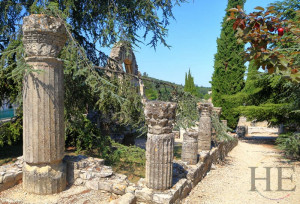
The sprawling foundation of a wealthy Roman villa, the House of the Messii, fascinates modern visitors. You’ll see how hot air flowed under the floors to keep the residents warm, while indoor plumbing kept them healthy. Continue on to the museum exhibiting artifacts found in the area, including various objects of worship and the only known statue of Emperor Hadrian with his wife Sabina — he was more often seen with his boyfriend Antinous. Finally, roam the impressive outdoor theater, extensively restored in the 1930s.
You’ll also admire the Roman Bridge. This single-arch bridge has endured 2000 years of use and abuse, including a German bomb dropped on it in World War II and a 1992 flood in which a 50-foot wall of water carried off two newer bridges and 30 people. Across the river lies the upper town, where grand old buildings line the cobble-stoned streets below the chateau.
A short and enjoyable bike ride along shaded forest roads takes you to the hilltop village of Seguret. Several shops in this delightful village offer handcrafts you would be proud to take home. Toward the top of the town is the Michelin-starred restaurant, La Table du Comtat. Lunch here will be long remembered.
Day 7: Wine and Romans
Vaison-la-Romaine to Avignon, 39 miles
It’s time to return to Avignon, but there’s much more to see and experience before we get there.
The Romans developed Orange as a colony for retired veterans — comfortable, but far enough from Rome that disgruntled vets couldn’t start a rebellion. We’ll stop at the well-preserved Triumphal Arch as we enter the city, then admire the world’s best-preserved Roman theater. Its’ excellent acoustics are still appreciated by audiences every summer. A short walk to Orange’s hilltop park offers a panorama of red-tiled rooftops.
Just down the road is one of the world’s most famous wine centers: Chateauneuf-du-Pape. Every available inch of precious land is devoted to vines. There’s no better spot to sample some fine wine (and our van will be ready if you decide to make a purchase). Incidentally, the soil here is not as rocky as it first appears. Stones are placed under the vines to absorb the bright daytime sun, radiating it back up in the evening.
Overlooking the town is the structure that gave Chateauneuf-du-Pape its name: The Pope’s Summer Palace. The Popes of Avignon grew fond of the vineyards here, and John XII selected it as the site of his new summer “home”. The palace survived for many centuries afterward, only to be bombed by retreating Germans at the close of World War II. Several walls still stand, overlooking the Rhone valley.
Continue past fields of red poppies, and soon we’re in Avignon. You may want to arrive early so you can tour the inside of the Papal Palace, or visit Fort St. Andre across the river. Then get ready for a special dinner at one of Provence’s preeminent restaurants.
Day 8: Departure
The hardest thing about our trips is saying goodbye to a wonderful group of new friends, and a charming region of France. If you’ve got extra vacation time to spend in Europe, we suggest you save it for after the trip, rather than before. Chances are there will be others from this week’s adventure who would like some company for a weekend in Paris.
Price Includes
Price includes: Comfortable hotels each night; Services of two tour guides; All breakfasts, 2 lunches, and 5 dinners with wine included; Transportation to get luggage (and tired riders!) to the destination; Use of a bike; A wine-tasting; Map and routes. HE Travel provides complimentary Medical & Evacuation Insurance for every US Resident on our group tours who does not have other coverage.
Not included: Travel to and from Avignon; 4 lunches; 2 dinners; Souvenirs, snacks, admissions; Gratuities for guides.
Optional Tour Choices:
TBA Single Supplement (for solo travelers who wish to enjoy a private bedroom and bathroom)
Extensions
When you travel “Back-to-Back” on two or more of our tours, you are eligible for a discount!
Tour Insurance
We strongly recommend the purchase of Trip Cancellation and Interruption insurance to protect your vacation investment in case of unforeseen circumstances such as flight delay, illness, or injury. Click Here to learn more about our Insurance partner.
FAQ
Avignon is easily reached by train from Paris; it's about a 4-hour ride on the high-speed TGV train, which you can catch right at Charles de Gaulle airport, or in downtown Paris.
Avignon has two train stations: Avignon Centre is right outside the town wall. Avignon TGV station is a short cab ride from town; there are also shuttle buses. (TGV trains, as of this writing, can use either station.) You can also fly into Avignon from Paris and take a cab (about $20) to our hotel.
You can get up-to-date rail schedules, as well as information about rail passes for France, and other European travel, from RailEurope. (In the U.S.: 888-794-7747.) For trains from Paris, you can select Paris (for trains departing from downtown stations) or Paris CDG Airport for direct trains from Charles de Gaulle Airport.
June through August are the driest months, but it’s unusual for us to have more than one or possibly two days of rain at other times in the spring or fall. On a majority of our bike trips in France, we’ve had half a day of rain or less. But, of course, we can’t promise anything about the weather. You can have a great time even if conditions turn out to be a little warmer, colder, or wetter than usual, as long as you bring suitable clothing. We’ll send some suggestions well in advance of the trip.
The Peter Mayle of a few generations ago was Alphonse Daudet (1840-1897), whose Letters From My Mill paints a colorful portrait of life in Provence. You can visit his historic windmill, still standing in a windswept clearing amongst the olive trees, on our Provencal trip.
A favorite book of ours is Pillars of the Earth by Ken Follett. He’s taken a subject in which he’s keenly interested (the building of cathedrals in the Middle Ages) and woven a compelling novel around it.
We also recommend Travelers' Tales France. The editors have collected the best essays about life and travel in France from over a dozen writers, including Peter Mayle, M.F.K. Fisher, Alice Kaplan, and Jon Krakauer. Their varied perspectives provide fascinating reading for anyone who's about to visit or has visited, France.

